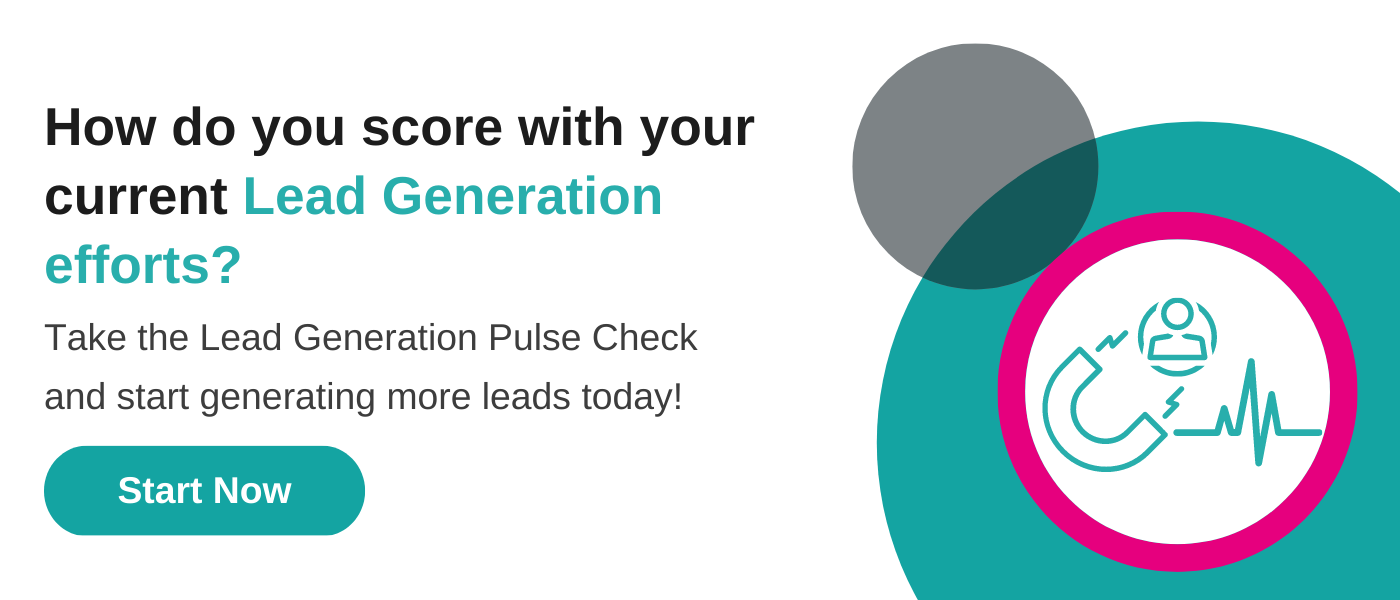There is no one-size-fits-all approach when it comes to lead generation. The methods you choose will depend on a number of factors, including your overall marketing strategy, resources, business objectives and industry.
That said, there are some tried-and-tested tactics you might want to try out. It’s worth remembering that successful B2B lead generation is rarely the result of a single channel doing it all alone but a combination of channels working together. Here are four reliable ways to generate leads for your business.
Email marketing
Email is the channel most people commonly associate with lead gen. It consistently ranks as the number one lead generation tactic among our Marketing Directors. Email lead gen typically involves sending promotional emails (often a combination of content and calls-to-action) to existing contacts or lists of contacts that you’ve bought.
Emails are usually sent in campaigns or sequences as opposed to one-offs, with the goal of building trust and adding value over time. The odds of success for each individual email are low, but contacts lists tend to be large and each contact will usually receive 5-7 emails over the course of a few weeks or months.
When done at scale, email is a pretty reliable way of generating genuine leads, provided you’re sending the right messages to the right people in the right order.
Time to leads
While there’s a chance you could get an instant response from a marketing email, it usually takes at least a few months to start getting responses. This can be accelerated if you’re able to make recipients a short-term offer that prompts a response, or tie your email to events in the real world, such as the end of the financial year.
Cost-effectiveness
The cost of sending emails is incredibly low and email tools are cheap. The most expensive part of email marketing is often the list, but this doesn’t cost much and once you have the data you can use it as much as you want (although be sure not to pester people too much).
Longevity
Individual emails have short lifespans. If they’re not acted on right away they’ll usually get ignored or forgotten about quite quickly. That said, an email campaign that’s proven to be effective can be used again and again for years and optimised over time to further increase performance.
Keep in mind
Email marketing is a numbers game. One email to a few prospects won’t do anything. But consistently sending a few hundred emails to the right people each month can have a massive impact, provided your email copy is a good match for the list and you’re making a sensible offer. Check out our guide on How to do outbound email. We also shared some great tips on how to improve the performance of your marketing emails.
If your company is B2C, your use of email will be severely restricted under GDPR. B2B companies have more leeway because they can build a case for emailing prospects them on the grounds of Legitimate Interest.
Search Engine Optimisation (SEO)
SEO is the practice of making your website more discoverable and appealing to search engines and their users. It increases the number and quality of visitors to your website by improving your rankings in search engine results. The end goal is to make sure that when people are searching for things that you can help with, your website gets recommended.
Time to leads
SEO is a long-term play. It typically takes at least 4-6 months to make an impact and even then, you’re unlikely to see the full impact until about 12 months in.
Cost-effectiveness
SEO is technically free. You can do it yourself using free tools and online tutorials. However, most people choose to pay specialists to help them with the more technical and creative aspects of optimising your website and uploading relevant content to it.
Since SEO tends to be a long-term commitment (more on this below), while ostensibly free, in practice it’s rarely cheap or fast. However, when done well, it can generate a lot of high-value traffic for your website.
Longevity
As long as you use a reputable company to implement your SEO and ensure it’s done properly, it should stand the test of time. In fact, search traffic tends to compound. The more traffic you get, the better your rankings. This makes SEO a very powerful channel if you’re willing to commit long-term. Check out our deep dive to find out if SEO is right for your business.
Keep in mind
To optimise how Google, Bing or other search engines rank your site, you need to make sure your website is accessible, that it features words or phrases that people might type into search engines, and that the quality of your content is high and includes relevant calls to action.
Another important consideration is your field or industry. If you operate within a niche area, you will need to carefully research your SEO keywords as the volume of searches will be low and highly specific.
What are the top lead generation tactics in the UK right now? Check out our original research to find out where you should be investing.
Content
The law of reciprocity is powerful. One of the best ways to generate leads for your business is to give prospects something valuable for free. Most of the time, in a B2B context, this takes the form of advice or expertise.
We’ve been using content to generate leads for our business for years. By sharing our experience and expertise on our website (like we’re doing here), we generate over 10,000 visits a month and a steady stream of contacts and enquiries. Engaging, authoritative content has the power to position you as a thought leader within your field which, in turn, can help to build your brand reputation.
Time to leads
Content marketing is a long-term play, just like SEO. It will take your team time to learn how to create high-quality content on a regular basis and longer still to build up an audience of people who trust your advice and seek it out. The likely time horizon for results is six months or more.
Cost-effectiveness
Just like SEO, content is technically free. Anyone can sit down, write a blog post and publish it on their website. But while more or less everyone can write, not everyone can create content that’s entertaining, interesting and informative. Business owners that don’t have a marketing background usually choose to outsource the creation of content to specialist content creators.
Tools like ChatGPT will certainly make it easier for non-specialists to create content. But at least for the time being, some kind of manual effort is still required to create high-quality content that people want to read.
Longevity
Great content stands the test of time. If you produce something of true value, it will be revisited and referenced for years. And, when it really is past its sell by date, you can always update and refresh it.
Keep in mind
Writing quality content is not as easy as it might seem. You need the right tone, the right attitude and relevant information. Churning out obvious self-promotion will look exactly like what it is. People want to read interesting, authentic pieces that will genuinely inform or help them in some way.
It’s also worth remembering that content needs to be distributed. In fact, you should invest just as much effort (if not more) distributing your content as you do in creating it. Sharing it on your website is a good start, but you should also create a distribution plan including posting it to social media, emailing it to contacts and optimising it for search. By doing this, your content will fuel all of the other lead gen strategies listed in the post.
Social media
It’s always sensible to reach people where they are. And these days, the people are on social media. In a B2B context, this typically means LinkedIn. As we’ve written about before, LinkedIn has a huge user base and is a powerful place to meet people, build relationships and generate leads.
That said, it’s important not to be too salesy. Social media is about interaction, not sales, and people that sell too directly will, at best, get ignored, and at worst, called out. Try to focus on genuine interaction and be as helpful as you can. We’ve found social media to be a great way to meet people and build relationships, but you have to be willing to take things slow.
Time to leads
Social media is a slow burn. It will take time to build up a network of contacts. You’re probably looking at about two to three months of consistent daily effort and engagement before you’re in a position to start initiating sales conversations. This is best done via DM, rather than in public. A good method is:
- Build the relationship in public by commenting on their content or having them comment on yours
- Sending a connection request to open a private conversation
- After a few positive interactions, suggest that you can probably help them and ask if they would like to jump on a call
Get more information on this approach, and other ways to use LinkedIn to generate leads.
Cost-effectiveness
It’s free to create an account, post content and interact with others on social media. You’re also less likely to need specialist support to do it well. Social media is a low-cost channel that can have a huge impact if you’re willing to turn up regularly and put the time in.
Longevity
Content on social media has a very short lifespan. Even the best content will only be seen and interacted with for a few days max. However, if you manage to build up an audience or a good network of contacts, this will have lasting impact and give you a valuable resource for years to come.
Keep in mind
A common mistake on social media is to use it to announce ‘company news’ or wins. While this type of content can get a good response, the real value lies in helping others and sharing your expertise - and interacting with other people who are doing the same.
A lot of business owners struggle knowing what to post. If you could do with some help, check out our list of LinkedIn post ideas for business owners.
Find the right lead gen tactics for your business
Whatever channel you’re choosing, successful lead generation is about playing the long game. It’s about adding value, building trust and then, when the time is right, making a clear and compelling offer.
As we said at the start, a truly effective lead generation strategy is likely to involve blending a few of the strategies we’ve looked at. By deploying a variety of lead generation tactics, you stand a better chance of optimising your reach, your brand presence and, ultimately, your sales.





